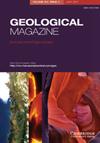Nature of the Shyok (Northern) Suture Zone between India and Asia: petrology, geochemistry and origin of the Tirit granitoids and associated dykes (Nubra Valley Ladakh Himalaya, NW India)
IF 2
3区 地球科学
Q3 GEOSCIENCES, MULTIDISCIPLINARY
引用次数: 0
Abstract
Abstract The Shyok Suture Zone is an oceanic remnant of the Neo-Tethyan ocean sandwiched between the Ladakh Batholiths to the south and Karakoram Batholith to the north. The Tirit granitoids in this suture are dark-coloured, relatively rich in ferromagnesian minerals and range from granodiorite–tonalite to gabbro–diorite in composition. Mafic igneous enclaves are quite common and they are intruded by NW–SE parallel doleritic and aplitic dykes. The Tirit granitoids have a wide range of major oxide compositions (SiO2 = 52.1–72.11 wt %, TiO2 = 0.21–1.23 wt %, Al2O3 = 11.42–13.52 wt %, MgO = 1.69–10.69 wt % and CaO = 3.24–9.31 wt %) and show calc-alkaline, metaluminous, I-type characteristics, transitional between primitive and mature arc continental plutons. Rare earth elements (REE) show considerable enrichment in light REE (LREE) as compared to the heavy REE (HREE). Late Cretaceous U/Pb dates (74–68 Ma) show that they formed during the pre-collision northward movement of India. The Tirit dykes are only slightly younger and probably part of the same episode.印度-亚洲Shyok(北)缝合带的性质:提尔里特花岗岩类及伴生岩脉的岩石学、地球化学及成因
Shyok缝合带是新特提斯洋的海洋遗迹,夹在南部的拉达克岩基和北部的喀喇昆仑岩基之间。该缝合带的提尔特花岗岩颜色较深,相对富含镁铁质矿物,成分从花岗闪长岩-闪长岩到辉长岩-闪长岩不等。基性火成岩包裹体相当普遍,它们被北西-东西平行的白云岩和灰岩岩脉侵入。提里特花岗岩的主要氧化物组成范围较广(SiO2 = 52.1 ~ 72.11 wt %, TiO2 = 0.21 ~ 1.23 wt %, Al2O3 = 11.42 ~ 13.52 wt %, MgO = 1.69 ~ 10.69 wt %, CaO = 3.24 ~ 9.31 wt %),具有钙碱性、铝质、i型特征,介于原始和成熟弧陆相岩体之间。稀土元素(REE)在轻稀土(LREE)中表现出较重稀土(HREE)的富集。晚白垩世U/Pb测年(74 ~ 68 Ma)表明它们形成于碰撞前印度向北运动时期。提尔特堤坝只是稍微年轻一点,可能是同一时期的一部分。
本文章由计算机程序翻译,如有差异,请以英文原文为准。
求助全文
约1分钟内获得全文
求助全文
来源期刊

Geological Magazine
地学-地球科学综合
CiteScore
4.70
自引率
0.00%
发文量
111
审稿时长
3 months
期刊介绍:
Geological Magazine, established in 1864, is one of the oldest and best-known periodicals in earth sciences. It publishes original scientific papers covering the complete spectrum of geological topics, with high quality illustrations. Its worldwide circulation and high production values, combined with Rapid Communications and Book Review sections keep the journal at the forefront of the field.
This journal is included in the Cambridge Journals open access initiative, Cambridge Open Option.
 求助内容:
求助内容: 应助结果提醒方式:
应助结果提醒方式:


